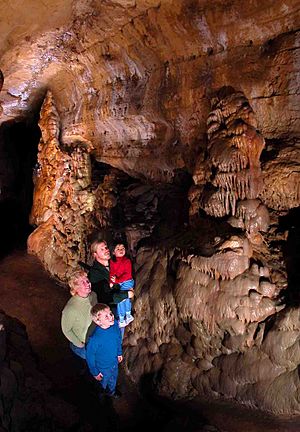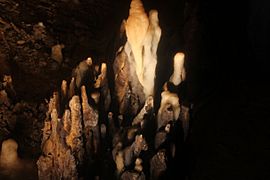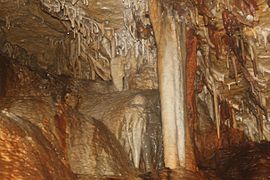Cave of the Mounds facts for kids
Quick facts for kids Cave of the Mounds |
|
|---|---|

Inside Cave of the Mounds
|
|
| Lua error in Module:Location_map at line 420: attempt to index field 'wikibase' (a nil value). | |
| Location | Blue Mounds, Wisconsin |
| Designated | 1987 |
Cave of the Mounds is a beautiful natural limestone cave found near Blue Mounds, Wisconsin, in the United States. It gets its name from two nearby hills called the Blue Mounds. This amazing cave is famous for its many different kinds of mineral formations, known as speleothems.
The Chicago Academy of Sciences calls Cave of the Mounds "the most important cave of the upper Midwest." It's even called the "jewel box" among major American caves because of how stunning it is. In 1987, the United States Department of the Interior and the National Park Service officially named it a National Natural Landmark. This means it's one of the best natural places in the country!
Contents
How the Cave Was Formed
The rock that makes up the cave is called limestone. It started forming about 488 million years ago. Back then, much of North America was covered by warm, shallow seas. Over millions of years, tiny sea creatures died, and their shells piled up on the seafloor. These shells were made of calcium carbonate, and they slowly turned into huge amounts of limestone. The specific type of limestone here is called galena dolomite. It has a lot of the lead ore called galena.
The Cave's Beginning
The cave itself began to form about one to one and a half million years ago. It started with a large crack in the rock, which is like the cave's "lifeline." Rainwater seeped into this crack. When rain falls through the air, it mixes with carbon dioxide. This creates a weak acid, like a very mild vinegar. Even though it's weak, this acid is strong enough to slowly dissolve the limestone as it seeps through the rock.
Over a very long time, large empty spaces formed inside the stone. As the underground water table (the level of water in the ground) dropped, the water drained out. The empty spaces then filled with air.
How Formations Grow
Now that the cave is filled with air, water droplets still come in through the "lifeline." These droplets are full of dissolved calcium carbonate. When the water evaporates, it leaves behind the solid calcium carbonate. This builds up slowly over time to create the amazing mineral formations called speleothems. This process is very slow, taking about 50 to 150 years to make just one cubic inch of material! It's still happening today.
The Cave's Discovery
The area around Blue Mounds was first settled by Europeans in 1828. A man named Ebenezer Brigham, who was a successful lead miner, moved there. He owned the land where the cave is today.
On August 4, 1939, the Cave of the Mounds was discovered by accident! Workers were blasting limestone in a quarry (a place where rock is dug out) when they exposed an opening to the cave. Work at the quarry stopped right away and never started again.
At first, the cave was closed. People were taking pieces of stalactites and stalagmites as souvenirs, which damaged the cave. You can still see foot-sized holes in the rock from these early visitors. The cave reopened in May 1940, after lights and wooden walkways were put in. Later, the wooden walkways were replaced with concrete ones for safety. Special lighting was also added to show off the cave's beautiful colors and shapes. In 1987, the cave became a National Natural Landmark. This means it's one of the best examples of natural features in the region.
Amazing Formations
Cave of the Mounds is home to many different kinds of speleothems. These are the mineral formations that make caves so special. Like most caves, it has many stalactites and stalagmites.
Here are some of the formations you can see inside the cave:
- Soda straws – These are thin, hollow tubes made of minerals. If the hole at the bottom gets plugged, they can grow into stalactites.
- Flowstones – These form when water flows along a surface and leaves minerals behind. In limestone caves, flowstones are usually the most common type of formation.
- Curtains – These look like wavy sheets of minerals. They form when water droplets run along the cave ceiling.
- Lily pads – These are created when water drops into a puddle. They form a flat shape on the surface, just like a lily pad.
- Helictites – These are unusual stalactites that grow in strange bends or angles. They seem to defy gravity! Their odd growth is probably caused by tiny forces acting on the water droplets.
- Oolites – Also called "cave pearls," these are rare and beautiful. They are round formations that look like pearls. They form when a water droplet falls onto a piece of sand, and calcite minerals build up around it.
These formations come in many bright colors like reds, browns, blues, and grays. The reds and browns are caused by iron in the minerals. Blues and grays come from manganese. Some speleothems even glow faintly for a short time after a light shines on them!
Visiting the Cave
The Cave of the Mounds is located about 20 miles west of Madison. You can find it off U.S. Highways 18/151 in Blue Mounds, Wisconsin. Since it opened in 1940, millions of people have visited this amazing natural wonder.




